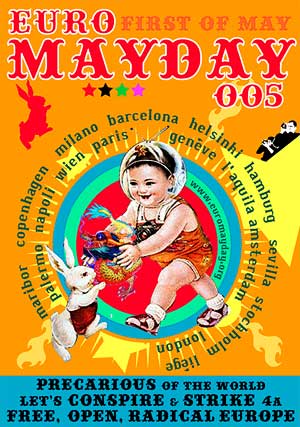posters
On the Importance of Protest Graphics
Compare and contrast:
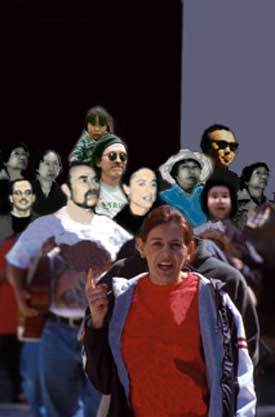
This is a crowd.
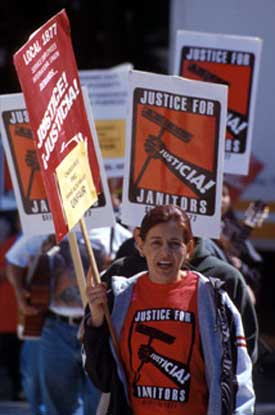
This is a movement.
There’s just nothing like a bold design to let them know what you want and when you want it.
Today’s excercise brought to you courtesy of Lincoln Cushing.
Motion and Movement
In that last blog item I’d written a line disdaining “media that dazzles instead of informs.”
I’ve been thinking about the AIGA MOVE conference, a two day affair on motion graphics design. It was painfully hip — lots of twenty-something, white guys with bad 70’s hair talking about their animated films, music videos, and electric art happenings. The reigning criteria seemed “Funny, Weird, or Cool.” The most useful and informative session was the only one on narrative — an odd number for an event billing itself on “stories in motion.”
But I struck out the line. It read as if I was saying these are mutually exclusive, which, of course, they are not. For a designer, I tend to be awfully suspicious of style — particularly of work that privileges style over clarity. But one musn’t forget the heart in the struggle for hearts and minds.
Favianna reminds me so:
“As a political poster artist, it is important for me to remind myself of ways to develop art that speaks to a mass base of people, so that my the art becomes something functional and not something to be purchased and sold. My posters don’t belong in galleries, they belong in schools, in the streets. Art in this country is commodified and transformed into something for commercial consumption. Our role as artists is to use our art to transform and inform a radical consciousness and to move the people.”
Euro May Day
William Thake sends notice of this spectacular image promoting EuroMayDay 2005:
See a bigger JPEG here or download a high rez PDF here (1.5 Mb, zipped).
The central image is drawn from a Chinese new year poster from the early 1970’s, celebrating both scientific prowess and folkloric tradition.
It’s interesting that the same image works for both Chinese statism and European anti-statism. Both are exuberant, celebratory, futurist, and utopian. But the European image is more self-consciously ‘kitsch’ than the Chinese. Is the European use ironic? Perhaps a comment on globalization? Kinda ambiguous, but it looks like fun.
A map of May Day events around Europe is posted here.
Call for Artwork: Reproduce and Revolt!
 Josh MacPhee is collecting submissions of graphics, illustrations and art for a book of freely reproducible graphics to be published by Soft Skull Press in late 2006.
Josh MacPhee is collecting submissions of graphics, illustrations and art for a book of freely reproducible graphics to be published by Soft Skull Press in late 2006.
He writes:
“Reproduce and Revolt!: Radical Graphics for the 21st Century is a graphic toolbox to be launched into the hands of political activists. The book will contain over 300 new and exciting high-quality illustrations and graphics about social justice and political activism for activists to use on flyers, posters, t-shirts, brochures, stencils or any other graphic aspects of political campaigns. All the graphics will be bold and easy to reproduce, in addition to being open source/anti-copyright. The book will come with clear instructions on how to best utilize the images so as to improve the graphic qualities of political campaigns. It will also contain a short history of political graphics, an archive of political flyers and posters throughout history, as well as information about and a bibliography of further reading for all of the social justice issues the art will cover....
Reproduce & Revolt! is not intended to be a who’s who of well known and successful political artists, this call is open to all levels of artists.”
Materials are due by October 31st, 2005. Contact ‘reproduce [at] justseeds [dot] org’ for more information.
Call for Artwork: Critical Mass
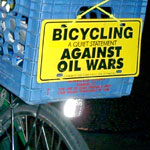 The daughter of a friend was arrested during the Republican National Convention. Her crime: riding her bicycle.
The daughter of a friend was arrested during the Republican National Convention. Her crime: riding her bicycle.
She was one of 5,000 people who rode with Critical Mass that clear August evening, and one of 250 arrested. She spent 25 hours in jail for riding her bike in support ecology, fewer cars, and a more bicycle friendly city.
“She lost a bit of innocence that summer,” says her mom.
Since the RNC, the New York Police Department have continued their campaign of intimidation and harassment, arresting riders and seizing bikes despite a court order. Now the Department is suing Time’s Up!, a nonprofit environmental group, to prevent them from participating in and promoting the rides and to enforce the ban on assembly of 20 or more people in a park without a permit.
The folks at Visual Resistance are facilitating a street art campaign in support of Critical Mass and are calling for designs. They hope to produce materials before the April 29th ride.
They will make the designs available for download and have a few printed. Some suggested themes include supporting/promoting Critical Mass; defending the right to free assembly; and promoting bicycling as a form of transportation.
For more info on Critical Mass and harassment by NYPD, visit the Time’s Up press room.
Poster designs should be 8.5x11 or 11x17 inches, sticker and stencil designs can be any logical size. Find out more.
People Before Profit
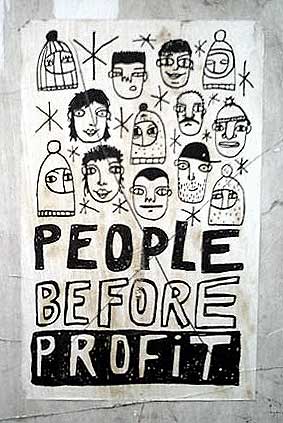
We’re not just against, we’re for!
Spotted somwhere in the 18th arrondissement.
The Great Seal
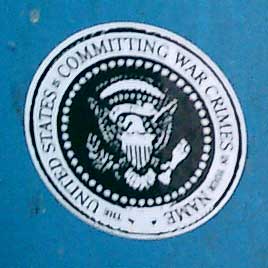
Spotted at North 7th street and Bedford Ave, Brooklyn
Taring Padi
Taring Padi in Bahasa Indonesia refers to the sharp tip, or “teeth,” of the rice plant. For the members of the Taring Padi Artists collective it is a metaphor for people power.
Fragments of the old Taring Padi Web site live on in the Internet Archive:
“taring padi is an independent non-profit cultural community which is based on the concept people’s culture. taring padi is committed to using its artistic and cultural pursuits to contribute actively to the democratisation process in indonesia and elsewhere. taring padi will continue to struggle for social justice and liberation from oppression for all peoples, and the environment.”
The collective creates posters and murals, publishes a newsletter, and participates in street performance with puppets, poetry, and musical groups.
From Inside Indonesia:
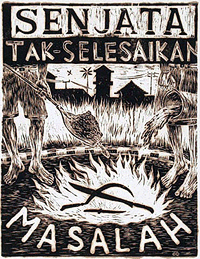 “Yogyakarta [a city in central Java] is renowned historically as a centre for radical cultural protest, particularly in the visual arts. Radical Yogya artists have embraced anti-colonial and revolutionary causes since early in the twentieth century. Like their predecessors, Taring Padi artists promote the concept of people’s art - seni kerakyatan — a loose term that defines the artist’s social commitment and popular orientation. Taring Padi attempt to put this credo into practise through concrete action, rather than just aesthetic empathy for the plight of the ‘oppressed masses.’
“Yogyakarta [a city in central Java] is renowned historically as a centre for radical cultural protest, particularly in the visual arts. Radical Yogya artists have embraced anti-colonial and revolutionary causes since early in the twentieth century. Like their predecessors, Taring Padi artists promote the concept of people’s art - seni kerakyatan — a loose term that defines the artist’s social commitment and popular orientation. Taring Padi attempt to put this credo into practise through concrete action, rather than just aesthetic empathy for the plight of the ‘oppressed masses.’
Mainstream art, the conventional system of curators, galleries and art collectors, is something Taring Padi avoid. Rather, they cultivate relations with other progressive organisations including students, farmers, and the urban poor. Such was the case for the World Food Day action, when Taring Padi collaborated with Mbah Seko and his group of organic farmers called Petani Lestari (Conservation Farmers), as well as with activists from the environmental non-government organisation Keliling. At the demonstration, activists shared out the protest wayangamong themselves. The cast of wayang figures symbolised the various ‘actors’ involved in the pesticide ‘drama’....
In the period before the June 1999 elections, a number of Indonesian cities experienced heightened unrest. Political commentators predicted ‘civil war,’ and the media fuelled the volatile pre-election atmosphere by nurturing perceived religious, ethnic and racial tensions. As a response, Taring Padi began to produce a series of woodcut posters which carried messages promoting solidarity and peaceful social interrelations. Between March and June 1999, they distributed approximately 10,000 woodcut posters throughout major cities in Java, Sumatra and South Sulawesi. The woodcuts, hand-printed on draft paper, were pasted on city streets, on churches and mosques, on village notice boards, in food stalls, in market places.
Among their other artwork, Taring Padi issue a popular pamphlet called The People’s Trumpet. A series of banners and murals resemble the work of Mexican muralist Diego Riviera. Taring Padi banners are often commissioned by other organisations. The women’s division of the National Human Rights Commission ordered a series of them. Titled The evacuation, the banners depict the harsh realities of the refugee crisis in Aceh by focusing on women’s daily struggles.
![]() But Taring Padi also use banners and murals for community purposes, and invite local people to be part of the painting process. Taring Padi’s creative ethos involves a collective, process-oriented production of artwork. They want to eliminate illusive notions of the artist as ‘genius’ or ‘eccentric’ individual, and of the artwork as somehow ‘sacred.’ Taring Padi artwork does not carry recognition of the ‘individual’ artistic creator. It is stamped instead with the Taring Padi ‘kerakyatan’ insignia — a sprig of rice, red star and cogwheel.”
But Taring Padi also use banners and murals for community purposes, and invite local people to be part of the painting process. Taring Padi’s creative ethos involves a collective, process-oriented production of artwork. They want to eliminate illusive notions of the artist as ‘genius’ or ‘eccentric’ individual, and of the artwork as somehow ‘sacred.’ Taring Padi artwork does not carry recognition of the ‘individual’ artistic creator. It is stamped instead with the Taring Padi ‘kerakyatan’ insignia — a sprig of rice, red star and cogwheel.”
See a collection of linocut prints and paintings.
Troubles
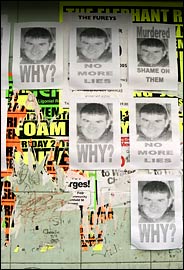 On the topic of posters and terrorism is this piece that ran in the NY Times two days ago about a growing backlash among Catholics to the violence of the Irish Republican Army.
On the topic of posters and terrorism is this piece that ran in the NY Times two days ago about a growing backlash among Catholics to the violence of the Irish Republican Army.
Five sisters are defying intimidation, calling for justice for the murder of their brother and “what is widely seen as a subsequent I.R.A. cover-up.”
As part of the effort, they are posting graphics in the street, both a rallying cry and public defiance of a sector of the community who would silence dissent in the name of the cause.
“Many Catholics in the McCartneys’ neighborhood, a battle-scarred area called the Short Strand, have responded with surprising solidarity.
On the day of the funeral for Mr. McCartney, a popular 33-year-old fork lift operator with two young sons, a thousand people turned up. Graffiti denouncing the I.R.A. popped up on walls, a first in a republican neighborhood; the markings were quickly erased, but quickly reappeared. Small photocopied posters with Mr. McCartney’s photograph appeared on shop windows. ‘No More Lies,’ one said. ‘Shame on Them,’ said another.
Last Sunday, the women held a rally in the neighborhood. Hundreds showed up, including politicians, and several speakers expressed outrage. The sisters held placards that read, ‘Murdered - Who’s Next?’
‘If these men walk free from this, then everyone in Ireland should fear the consequences,’ Paula McCartney, 40, a Queen’s University student, told the crowd, according to news reports. ‘Justice must be done.’”
It is a kind of grassroots resistance to the established resistance, adding further stigma to the violent tactics — from the constituency such tactics are theoretically supposed to benefit.
Still, one has to wonder about the sudden interest of the NY Times in such resistance. The Times is so rarely sympathetic to such activities by left-wing groups. Is it simply the hypocrisy of a righteous group acting less than righteously? Or there another agenda at work? While the I.R.A. may indeed have turned to thuggery (they wouldn’t be the first armed resistance to do so) I suspect a kind of arrogant Statism at play, the sisters provide a convenient proxy to bash those pesky agitators.
Malas Noticias / Bad News
Via email:
“Diseño para la solidaridad / Design for solidarity
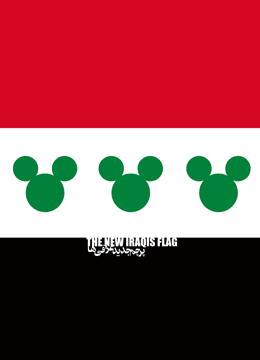 From the 8th to the 11th of March, Madrid welcomes an international summit
on ‘Democracy and Terrorism,’ in honor of the first anniversary of 11M. We
would like to take advantage of this international event so that designers
from different countries and cultures contribute their views and personal
opinions regarding this subject. We have created a virtual gallery and would
like to display in different spaces throughout the city with all the works
that we receive.
From the 8th to the 11th of March, Madrid welcomes an international summit
on ‘Democracy and Terrorism,’ in honor of the first anniversary of 11M. We
would like to take advantage of this international event so that designers
from different countries and cultures contribute their views and personal
opinions regarding this subject. We have created a virtual gallery and would
like to display in different spaces throughout the city with all the works
that we receive.
This is a project for the creation and free distribution of graphic material against terrorism and supporting the victims, on the first anniversary of the 11M terrorist attack in Madrid.
MISSION
This project intends to be a public design forum for the creation of images that express points of view on terrorism and promote public debate.
Bad news/ design for solidarity wants to be a symbol for democratic response and citizen participation, on behalf of designers, against terrorism on the first anniversary of the 11M.
The project is conceived as a space that is open to designers all over the world and comes forth parallel to the conference on "Democracy and Terrorism" that will be celebrated in Madrid in February of 2005.
Bad News/ Design for Solidarity hopes to be a symbol for international solidarity against terrorism. For this we need for you to contribute with your creativity and talent.”
When I received the first email about this, I was skeptical. Posters denouncing terrorism because it’s bad? Isn’t that the method of terrorism?
But when I received the second email I took another look. The inclusion of Reza Alavi’s ‘New Iraqis Flag’ and a poster linking war with Wall Street points towards a more interesting analysis of the subject. And promoting public discussion seems like a good way to go.
Submission details and a current gallery of posters are up at http://unmundofeliz.org.
page 19 18 17 16 15 14 13 12 11 10 9 8 7 6 5 4 3 2 1 Older »


